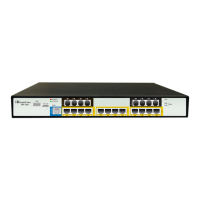User's Manual 124 Document #: LTRT-65422
MP-11x & MP-124
4. Configure the NFS parameters according to the table below.
5. Click the Submit button; the remote NFS file system is immediately applied, which
can be verified by the appearance of the 'NFS mount was successful' message in the
Syslog server.
6. To save the changes to flash memory, see 'Saving Configuration' on page 324.
Notes:
• To avoid terminating current calls, a row must not be deleted or modified
while the device is currently accessing files on that remote NFS file
system.
• The combination of 'Host Or IP' and 'Root Path' must be unique for each
row in the table. For example, the table must include only one row with a
Host/IP of 192.168.1.1 and Root Path of /audio.
• The NFS table can also be configured using the table ini file parameter
NFSServers (see 'NFS Parameters' on page 427)
Table 11-16: NFS Settings Parameters
Parameter Description
Index The row index of the remote file system.
The valid range is 1 to 16.
Host Or IP
[NFSServers_HostOrIP]
The domain name or IP address of the NFS server. If a domain name is
provided, a DNS server must be configured.
Root Path
[NFSServers_RootPath]
Path to the root of the remote file system in the format: /[path]. For
example, '/audio'.
NFS Version
[NFSServers_NfsVersion]
NFS version used to access the remote file system.
[2] NFS Version 2
[3] NFS Version 3 (default)
Authentication Type
[NFSServers_AuthType]
Authentication method used for accessing the remote file system.
[0] Null
[1] Unix (default)
User ID
[NFSServers_UID]
User ID used in authentication when using Unix.
The valid range is 0 to 65537. The default is 0.
Group ID
[NFSServers_GID]
Group ID used in authentication when using Unix.
The valid range is 0 to 65537. The default is 1.
VLAN Type
[NFSServers_VlanType]
The VLAN type for accessing the remote file system.
[0] OAM
[1] MEDIA (default)
Note: This parameter applies only if VLANs are enabled or if Multiple
IPs is configured (see 'Configuring IP Network Interfaces' on page 105).
11.8 Network Address Translation Support
Network Address Translation (NAT) is a mechanism that maps internal IP addresses (and
ports) used within a private network to global IP addresses and vice versa, providing
transparent routing to end hosts. The primary advantages of NAT include (1) reduction in

